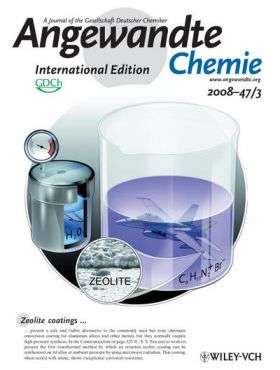Scientist Makes Another Breakthrough on Corrosion-Resistant Zeolite Coating

Hexavalent chromium played the villain in the film “Erin Brockovich,” causing severe and permanent health problems for people living near a power plant.
UC Riverside Professor Yushan Yan and his colleagues were the first to demonstrate that zeolite coatings could replace traditional hexavalent chromium coatings widely used in aerospace and defense applications. Now they have discovered a new way to bring the technology closer to commercialization.
Yan’s most recent paper, with co-authors from UCR’s Department of Chemical & Environmental Engineering and the Center for Environmental Research and Technology, was published as the cover story in Angewandte Chemie International Edition, the journal of the German Chemical Society.
Zeolite films are well-known as molecular sieves for membrane applications, but they may also be useful as nontoxic, corrosion-resistant coatings to replace chromate-based materials.
Over the years, the Environmental Protection Agency, the Department of Defense and the UC Toxic Substances Research and Teaching Program have closely followed Yan’s work; several years ago the team received a $1.6 million grant for their research from the Department of Defense.
The researchers used the approach to coat a corrosion-susceptible aluminum alloy commonly used in aerospace and defense applications with the silicoaluminophosphate zeolite SAPO-11. When deposited, the zeolite showed good resistance to pitting corrosion, especially when topped with a silane sealant.
“For commercial aircraft, approximately 75 percent of the weight is aluminum alloy,” explains Yan. “These alloys are light and have wonderful mechanical properties, but they are very prone to corrosion. If we can use corrosion resistant zeolite coatings commercially, we can eliminate the use of chromium, creating a significant environmental benefit.”
Hydrothermal zeolite coating methods Yan and coworkers developed in the past require high process pressures, which Yan says is difficult for the surface-finishing industry to adopt commercially. To make the coatings at ambient pressure, Yan and coworkers adapted a technique normally used to prepare zeolite powders. Their method relies on an “environmentally benign” ionic liquid solvent rather than water or an organic solvent.
Zeolite, a crystal composed of silicon dioxide and aluminum oxide, is not new. It is used in granular form as a catalyst for producing gasoline and as a media for separating air into oxygen and nitrogen. In addition to nontoxic, corrosion-resistant zeolite coatings, Yan has developed thin films of zeolite for semiconductor applications not explored before, as well as created very small zeolite crystals for use in fuel cells.
Source: University of California, Riverside


















